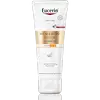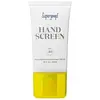What's inside
What's inside
 Key Ingredients
Key Ingredients

 Benefits
Benefits

 Concerns
Concerns

 Ingredients Side-by-side
Ingredients Side-by-side

Water
Skin ConditioningCetearyl Alcohol
EmollientAlcohol Denat.
AntimicrobialButyl Methoxydibenzoylmethane
UV AbsorberGlycerin
HumectantC12-15 Alkyl Benzoate
AntimicrobialCocoglycerides
EmollientButylene Glycol Dicaprylate/Dicaprate
EmollientBis-Ethylhexyloxyphenol Methoxyphenyl Triazine
Skin ConditioningDibutyl Adipate
EmollientEthylhexyl Salicylate
UV AbsorberEthylhexyl Triazone
UV AbsorberGlyceryl Stearate
EmollientButyrospermum Parkii Butter
Skin ConditioningDiethylamino Hydroxybenzoyl Hexyl Benzoate
UV FilterPhenylbenzimidazole Sulfonic Acid
UV AbsorberIsobutylamido Thiazolyl Resorcinol
BleachingSodium Hyaluronate
HumectantArctium Lappa Fruit Extract
AntioxidantTapioca Starch
Stearyl Alcohol
EmollientCaprylyl Glycol
EmollientSodium Stearoyl Glutamate
CleansingSodium Hydroxide
BufferingXanthan Gum
EmulsifyingSodium Chloride
MaskingPentaerythrityl Tetra-Di-T-Butyl Hydroxyhydrocinnamate
AntioxidantTrisodium EDTA
Phenoxyethanol
PreservativeParfum
MaskingWater, Cetearyl Alcohol, Alcohol Denat., Butyl Methoxydibenzoylmethane, Glycerin, C12-15 Alkyl Benzoate, Cocoglycerides, Butylene Glycol Dicaprylate/Dicaprate, Bis-Ethylhexyloxyphenol Methoxyphenyl Triazine, Dibutyl Adipate, Ethylhexyl Salicylate, Ethylhexyl Triazone, Glyceryl Stearate, Butyrospermum Parkii Butter, Diethylamino Hydroxybenzoyl Hexyl Benzoate, Phenylbenzimidazole Sulfonic Acid, Isobutylamido Thiazolyl Resorcinol, Sodium Hyaluronate, Arctium Lappa Fruit Extract, Tapioca Starch, Stearyl Alcohol, Caprylyl Glycol, Sodium Stearoyl Glutamate, Sodium Hydroxide, Xanthan Gum, Sodium Chloride, Pentaerythrityl Tetra-Di-T-Butyl Hydroxyhydrocinnamate, Trisodium EDTA, Phenoxyethanol, Parfum
Butyl Methoxydibenzoylmethane 3%
UV AbsorberEthylhexyl Salicylate 5%
UV AbsorberOctocrylene 10%
UV AbsorberWater
Skin ConditioningGlycerin
HumectantButyloctyl Salicylate
Skin ConditioningC12-15 Alkyl Benzoate
AntimicrobialCetearyl Alcohol
EmollientPropanediol
SolventGlyceryl Stearate Citrate
EmollientCocoglycerides
EmollientIsododecane
EmollientCetyl Esters
EmollientCetyl Phosphate
EmulsifyingDiisopropyl Sebacate
EmollientIsodecyl Neopentanoate
EmollientLauryl Lactate
EmollientArginine
Masking1,2-Hexanediol
Skin ConditioningCaprylyl Glycol
EmollientHydroxyacetophenone
AntioxidantPolymethylsilsesquioxane
Raphanus Sativus Seed Oil
EmollientDiethylhexyl Syringylidenemalonate
Skin ProtectingHelianthus Annuus Seed Wax
Skin ConditioningLimnanthes Alba Seed Oil
Skin ConditioningAcrylates/C10-30 Alkyl Acrylate Crosspolymer
Emulsion StabilisingChlorphenesin
AntimicrobialXanthan Gum
EmulsifyingTrisodium Ethylenediamine Disuccinate
Argania Spinosa Kernel Oil
EmollientCaprylic/Capric Triglyceride
MaskingCitrus Nobilis Peel Oil
MaskingPlantago Lanceolata Leaf Extract
AntimicrobialGlycine Soja Oil
EmollientTocopherol
AntioxidantCymbopogon Schoenanthus Oil
MaskingHippophae Rhamnoides Fruit Oil
Skin ProtectingElettaria Cardamomum Seed Oil
MaskingEugenia Caryophyllus Leaf Oil
MaskingCinnamomum Cassia Leaf Oil
MaskingVanillin
MaskingEucalyptus Globulus Leaf Oil
PerfumingLavandula Hybrida Grosso Herb Oil
PerfumingButyl Methoxydibenzoylmethane 3%, Ethylhexyl Salicylate 5%, Octocrylene 10%, Water, Glycerin, Butyloctyl Salicylate, C12-15 Alkyl Benzoate, Cetearyl Alcohol, Propanediol, Glyceryl Stearate Citrate, Cocoglycerides, Isododecane, Cetyl Esters, Cetyl Phosphate, Diisopropyl Sebacate, Isodecyl Neopentanoate, Lauryl Lactate, Arginine, 1,2-Hexanediol, Caprylyl Glycol, Hydroxyacetophenone, Polymethylsilsesquioxane, Raphanus Sativus Seed Oil, Diethylhexyl Syringylidenemalonate, Helianthus Annuus Seed Wax, Limnanthes Alba Seed Oil, Acrylates/C10-30 Alkyl Acrylate Crosspolymer, Chlorphenesin, Xanthan Gum, Trisodium Ethylenediamine Disuccinate, Argania Spinosa Kernel Oil, Caprylic/Capric Triglyceride, Citrus Nobilis Peel Oil, Plantago Lanceolata Leaf Extract, Glycine Soja Oil, Tocopherol, Cymbopogon Schoenanthus Oil, Hippophae Rhamnoides Fruit Oil, Elettaria Cardamomum Seed Oil, Eugenia Caryophyllus Leaf Oil, Cinnamomum Cassia Leaf Oil, Vanillin, Eucalyptus Globulus Leaf Oil, Lavandula Hybrida Grosso Herb Oil
Ingredients Explained
These ingredients are found in both products.
Ingredients higher up in an ingredient list are typically present in a larger amount.
Also known as Avobenzone, this ingredient is a chemical sunscreen filter that provides protection in the UV-A range.
Avobenzone is globally approved and is the most commonly used UV-A filter in the world.
Studies have found that avobenzone becomes ineffective when exposed to UV light (it is not photostable; meaning that it breaks down in sunlight). Because of this, formulations that include avobenzone will usually contain stabilizers such as octocrylene.
However, some modern formulations (looking at you, EU!) are able to stabilize avobenzone by coating the molecules.
Avobenzone does not protect against the UV-B range, so it's important to check that the sunscreen you're using contains other UV filters that do!
The highest concentration of avobenzone permitted is 3% in the US, and 5% in the EU.
Learn more about Butyl MethoxydibenzoylmethaneC12-15 Alkyl Benzoate is made up of Benzoic Acid and long chain alcohols. It has a low molecular weight.
C12-15 Alkyl Benzoate is an emollient and texture enhancer. Due to its solubility, it is often used in sunscreens to help evenly distribute active ingredients.
As an emollient, C12-15 Alkyl Benzoate helps soften and hydrate your skin. Emollients create a film on your skin that traps moisture within.
This ingredient has been reported to cause eye irritation.
Learn more about C12-15 Alkyl BenzoateCaprylyl Glycol is a humectant and emollient, meaning it attracts and preserves moisture.
It is a common ingredient in many products, especially those designed to hydrate skin. The primary benefits are retaining moisture, skin softening, and promoting a healthy skin barrier.
Though Caprylyl Glycol is an alcohol derived from fatty acids, it is not the kind that can dry out skin.
This ingredient is also used as a preservative to extend the life of products. It has slight antimicrobial properties.
Learn more about Caprylyl GlycolCetearyl alcohol is a mixture of two fatty alcohols: cetyl alcohol and stearyl alcohol. It is mainly used as an emulsifier. Emulsifiers help prevent the separation of oils and products. Due to its composition, it can also be used to thicken a product or help create foam.
Cetearyl alcohol is an emollient. Emollients help soothe and hydrate the skin by trapping moisture.
Studies show Cetearyl alcohol is non-toxic and non-irritating. The FDA allows products labeled "alcohol-free" to have fatty alcohols.
This ingredient is usually derived from plant oils such as palm, vegetable, or coconut oils. There is debate on whether this ingredient will cause acne.
Due to the fatty acid base, this ingredient may not be Malassezia folliculitis safe.
Learn more about Cetearyl AlcoholCocoglycerides is made from the mono, di and triglycerides of coconut oil. It is an emollient and emulsifer.
Emollients are a type of moisturizer. They create a thin film on top of the skin. This film prevents moisture from escaping, keeping the skin hydrated.
Emulsifiers prevent ingredients from separating. Examples of this include oils and water, which naturally do not mix. Emulsifiers helps elongate the shelf life of a product. They also help the product stay consistent in texture.
Learn more about CocoglyceridesEthylhexyl Salicylate is an organic compound used to block UV rays. It primarily absorbs UVB rays but offers a small amount of UVA protection as well.
Commonly found in sunscreens, Ethylhexyl Salicylate is created from salicylic acid and 2-ethylhexanol. You might know salicylic acid as the effective acne fighter ingredient and BHA.
The ethylhexanol in this ingredient is a fatty alcohol and helps hydrate your skin, similar to oils. It is an emollient, which means it traps moisture into the skin.
According to manufacturers, Ethylhexyl Salicylate absorbs UV wavelength of 295-315 nm, with a peak absorption at 307-310 nm. UVA rays are linked to long term skin damage, such as hyperpigmentation. UVB rays emit more energy and are capable of damaging our DNA. UVB rays cause sunburn.
Learn more about Ethylhexyl SalicylateGlycerin is already naturally found in your skin. It helps moisturize and protect your skin.
A study from 2016 found glycerin to be more effective as a humectant than AHAs and hyaluronic acid.
As a humectant, it helps the skin stay hydrated by pulling moisture to your skin. The low molecular weight of glycerin allows it to pull moisture into the deeper layers of your skin.
Hydrated skin improves your skin barrier; Your skin barrier helps protect against irritants and bacteria.
Glycerin has also been found to have antimicrobial and antiviral properties. Due to these properties, glycerin is often used in wound and burn treatments.
In cosmetics, glycerin is usually derived from plants such as soybean or palm. However, it can also be sourced from animals, such as tallow or animal fat.
This ingredient is organic, colorless, odorless, and non-toxic.
Glycerin is the name for this ingredient in American English. British English uses Glycerol/Glycerine.
Learn more about GlycerinWater. It's the most common cosmetic ingredient of all. You'll usually see it at the top of ingredient lists, meaning that it makes up the largest part of the product.
So why is it so popular? Water most often acts as a solvent - this means that it helps dissolve other ingredients into the formulation.
You'll also recognize water as that liquid we all need to stay alive. If you see this, drink a glass of water. Stay hydrated!
Learn more about WaterXanthan gum is used as a stabilizer and thickener within cosmetic products. It helps give products a sticky, thick feeling - preventing them from being too runny.
On the technical side of things, xanthan gum is a polysaccharide - a combination consisting of multiple sugar molecules bonded together.
Xanthan gum is a pretty common and great ingredient. It is a natural, non-toxic, non-irritating ingredient that is also commonly used in food products.
Learn more about Xanthan Gum